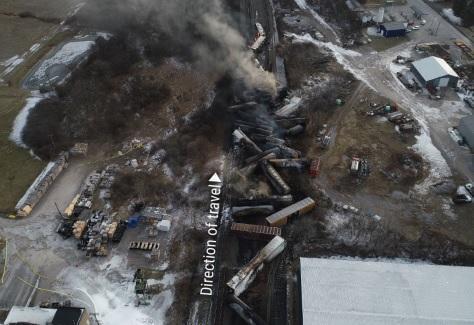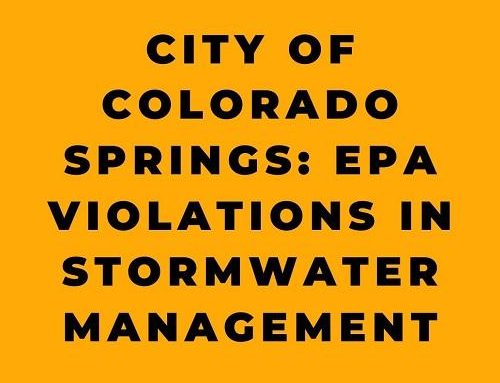Today we’re talking about the Norfolk Southern Railway Train Derailment in East Palestine, Ohio that happened on February 3, 2023. Now, I want to start off by saying that this information is preliminary and subject to change, but we’re going to give you the most up-to-date info we have.
To download the NTSB report (PDF format), and read it for yourself, use this link:
NTSB Preliminary Report on East Palestine Derailment
The National Transportation Safety Board (NTSB) just released their preliminary report on the derailment this morning. According to preliminary findings from the National Transportation Safety Board, it looks like one of the train’s wheel bearings got pretty darn hot – 253 degrees above ambient temperatures to be exact. It’s still early days, but this could be a clue as to what caused the derailment
So, on the night of February 3rd, around 8:54 pm local time, an eastbound Norfolk Southern Railway (NS) general merchandise freight train 32N derailed 38 railcars on main track 1 of the NS Fort Wayne Line of the Keystone Division in East Palestine, Ohio. This included 11 tank cars carrying hazardous materials that subsequently ignited, fueling fires that damaged an additional 12 non-derailed railcars.
Now, here’s the kicker, folks. First responders had to implement a 1-mile evacuation zone surrounding the derailment site that affected up to 2,000 residents. Can you believe that? Luckily, there were no reported fatalities or injuries. At the time of the accident, visibility conditions were dark and clear, and the weather was 10°F with no precipitation.
Train 32N comprised of 2 head-end locomotives, 149 railcars, and 1 distributed power locomotive located between railcars 109 and 110. The consist included 20 placarded hazardous materials tank cars transporting combustible liquids, flammable liquids, and flammable gas, including vinyl chloride. Train 32N was traveling about 47 mph at the time of the derailment, which was less than the maximum authorized timetable speed of 50 mph.
Train movements near the derailment site are authorized by cab signals and wayside signal indications with an overlaid positive train control system and are coordinated by the NS Cleveland East train dispatcher located in Atlanta, Georgia. The positive train control system was enabled and operating at the time of the derailment.
Now, let’s talk about the wayside defect detector or hot bearing detector. On February 3rd, as train 32N passed the detector, it transmitted a critical audible alarm message instructing the crew to slow and stop the train to inspect a hot axle. The train engineer increased the dynamic brake application to further slow and stop the train, and during this deceleration, an automatic emergency brake application initiated, and train 32N came to a stop.
Train 32N passed three HBD systems on its trip before the derailment. At MP 79.9, the suspect bearing from the 23rd car had a recorded temperature of 38°F above ambient temperature. When train 32N passed the next HBD, at MP 69.01, the bearing’s recorded temperature was 103°F above ambient. The third HBD, at MP 49.81, recorded the suspect bearing’s temperature at 253°F above ambient.
After the train stopped, the crew observed fire and smoke and notified the Cleveland East dispatcher of a possible derailment. With dispatcher authorization, the crew applied handbrakes to the two railcars at the head of the train, uncoupled the head-end locomotives, and moved the locomotives about 1 mile from the uncoupled railcars. Responders arrived at the derailment site and began response efforts.
Now, here’s where it gets interesting. On February 5, responders mitigated the fire, but five derailed DOT-105 specification tank cars carrying 115,580 gallons of vinyl chloride continued to concern authorities because the temperature inside one tank car was still rising. This increase in temperature suggested that the vinyl chloride was undergoing a polymerization reaction, which could pose an explosion hazard. Responders scheduled a controlled venting of the five vinyl chloride tank cars to release and burn the vinyl chloride, expanded the evacuation zone to a 1-mile by 2-mile area, and dug ditches to contain released vinyl chloride liquid while it vaporized and burned. The controlled venting began about 4:40 p.m. on February 6 and continued for several hours. Fortunately, the controlled burn of the vinyl chloride was successful, and there were no additional explosions or fires as a result. This event underscored the critical role of first responders in managing hazardous materials incidents and the importance of ongoing safety training and preparedness measures for all stakeholders involved. The controlled burn helped to minimize the risk to the surrounding community.
While on the scene, the NTSB investigators examined the railroad equipment and track conditions and reviewed data from various sources, including the signal system, wayside defect detectors, local surveillance cameras, and the lead locomotive’s event recorder and forward-facing and inward-facing image recorders. The investigators also conducted interviews with relevant parties and identified and examined the first railcar to derail, which was the 23rd railcar in the consist.
Surveillance footage from a local residence revealed what appeared to be a wheel bearing in the final stage of overheat failure just moments before the derailment. The wheel bearing and affected wheelset were collected as evidence and will be examined by the NTSB. The NTSB also removed and examined the vinyl chloride tank car top fittings, including the relief valves, on the scene. These top fittings will be shipped to Texas for testing under the NTSB’s direction.
–
Following the derailment and subsequent hazardous material release and fires, the hazardous material tank cars were decontaminated. On February 21, 2023, the NTSB investigators returned to Ohio to examine each hazardous material tank car, document damage, and secure evidence for laboratory analysis. The NTSB’s investigation into the incident is ongoing.
The NTSB’s future investigative activities will focus on various aspects of the derailment, including the wheelset and bearing, tank car design and derailment damage, accident response, railcar design and maintenance procedures and practices, NS use of wayside defect detectors, and NS railcar inspection practices.
It is important to note that the NTSB is not involved in air monitoring, testing of water quality, environmental remediation, or evacuation orders. Any questions regarding environmental issues related to the derailment should be referred to the Environmental Protection Agency.
In summary, the Norfolk Southern Railway train derailment and subsequent hazardous material release and fires that occurred on February 3, 2023, in East Palestine, Ohio, was a significant incident that required an extensive response effort from first responders and investigators. While no fatalities or injuries were reported, the incident resulted in a 1-mile evacuation zone being implemented, affecting up to 2,000 residents. The NTSB’s investigation into the incident is ongoing, with a focus on various aspects of the derailment, including the wheelset and bearing, tank car design and derailment damage, accident response, railcar design and maintenance procedures and practices, Norfolk Southern’s use of wayside defect detectors, and NS railcar inspection practices.
References:










